How to Identify Pure Honey
A honey’s texture tells a lot about its composition. A liquid honey implies more water or fructose sugars, while a thicker, crystallized honey implies low water content and more glucose sugars. While this is true for natural honeys, what if there is something else thickening that honey? Has it been mixed with sugar or syrup for artificial sweetness or added volume? While you can’t know exactly whats in the jar without testing, there are some simple ways to differentiate pure honey from those that are mixed with sugar.
Nowadays, it is not uncommon to find either commercial or small scale honey producers are actually mixing their honey with sugar in order to lower product cost and slyly increase profit. Many people have their own tricks and techniques for distinguishing the real from the fake. You may see honey salesmen pouring out droplets of honey; according to them, if the honey “runs” it may be contaminated, but a real honey will stick to the surface, keeping its structure.
According to Aziz Zombe, one of the Maasai Honey beekeeping instructors, thick, crystallized honey is often thought to be mixed with sugar when really this can be sign a sign of high quality honey! This is because moisture plays a big part in honey quality. Low quality honeys make have too much water, which may cause them to ferment over time, whereas a high quality honey has a low water content, allowing it to last almost indefinitely! Zombe suggests that if you want test whether crystallized honey is pure or mixed, place it out in the sun. Pure, crystallized honey will change state rather quickly, while sugar particles will take a long time to dissolve in the sun.
Packaging honey in the production room at Maasai Honey.
Beekeeper Parkin examines a honey sample through a refractometer to measure its water content.


